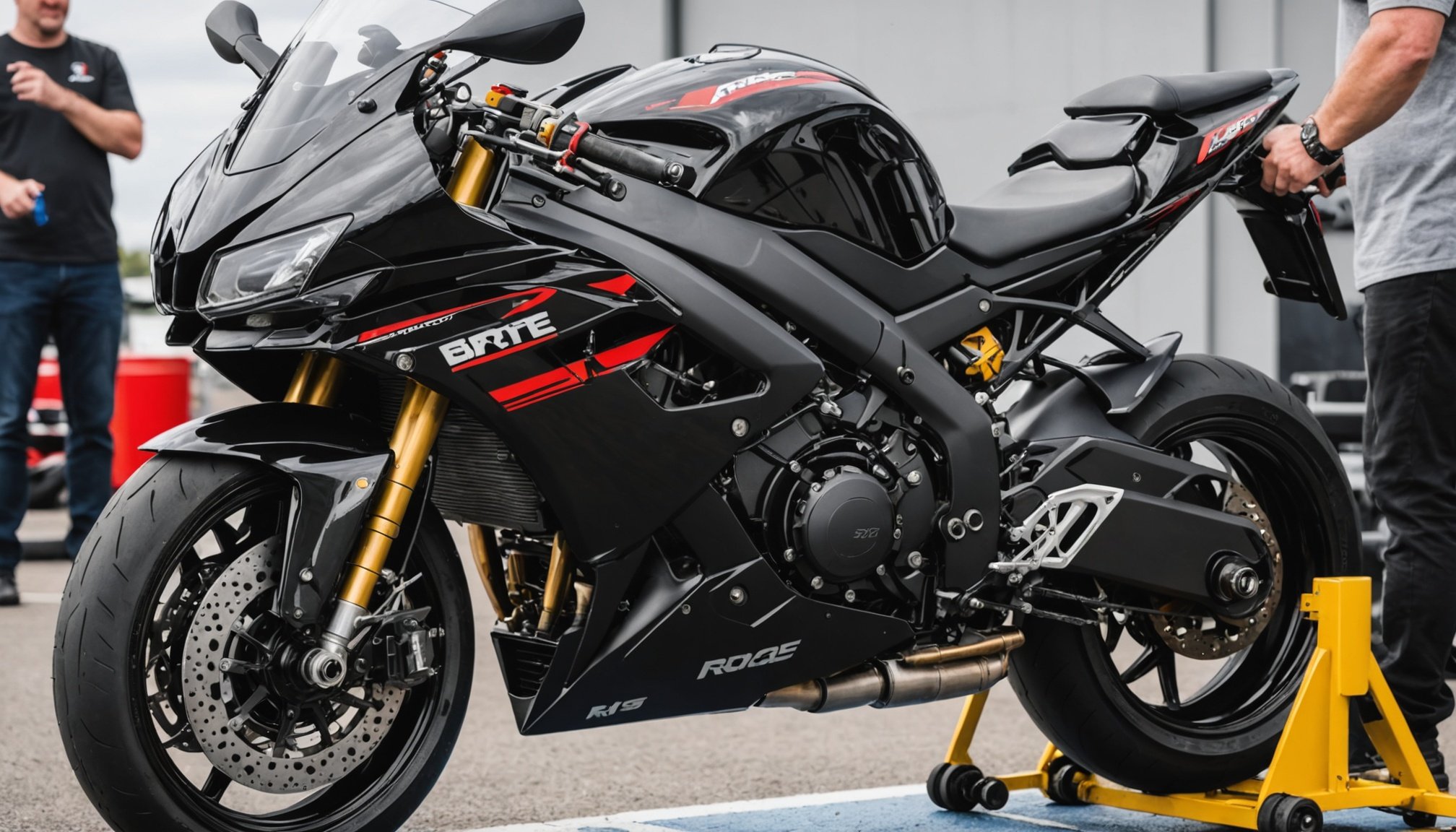Ultimate Guide: How to Properly Check and Adjust Your Sport Bike Suspension Preload for a UK Track Day
Understanding the Basics of Motorcycle Suspension
Before diving into the intricacies of adjusting your sport bike’s suspension preload, it’s crucial to grasp the fundamentals of how your bike’s suspension works. Your motorcycle’s suspension is composed of several key components: forks, shocks, springs, and dampers. Each of these components plays a vital role in ensuring a smooth and responsive ride.
- Forks: Located at the front, forks are pivotal in steering and absorbing bumps. They are responsible for maintaining the front end’s stability and handling.
- Shocks: Usually found at the rear, shocks help maintain stability and comfort by absorbing larger impacts.
- Springs: These support the bike’s weight and are crucial for maintaining the ride height.
- Dampers: Dampers control the speed of the suspension’s movement, preventing excessive bouncing and ensuring the bike stays stable[5].
The Importance of Preload in Your Suspension Setup
Preload is the initial compression of the spring before any external load is applied. Adjusting the preload is essential for ensuring that your bike’s suspension is set up correctly for your weight and riding style.
Also read : Mastering Adjustable Sport Bike Suspension: The Best Settings for Conquering UK’s Twisting Roads
Why Preload Matters
- Ride Height: Proper preload ensures the correct ride height, which is critical for maintaining the bike’s geometry and handling characteristics. If the preload is too low, the bike may sag excessively, affecting its stability and cornering ability. Conversely, too much preload can make the bike feel stiff and unyielding[3].
- Spring Rate: While preload adjustment does not change the spring rate, it is crucial to understand that the spring rate (or stiffness) of your bike’s suspension directly impacts how your bike handles. A spring with a high rate is stiffer and requires more force to compress, while a spring with a low rate is softer and compresses more easily[3].
Setting the Preload: A Step-by-Step Guide
Setting the preload correctly is a process that requires patience and attention to detail. Here’s a step-by-step guide to help you get it right:
Determine Your Rider Sag
Rider sag, or dynamic sag, is the amount the suspension compresses when you are sitting on the bike in your normal riding position. Here’s how to measure it:
Also read : Essential Guide to Winterizing Your Sport Bike in the UK: Key Steps to Avoid Engine Damage
- Air-Sprung Suspension: Inflate the air spring in the fork or shock to the recommended pressure for your weight. This can be found in the manufacturer’s manual or often printed on the back of one leg of the fork[1].
- Static Sag: Measure the static sag by placing the bike on a stand and measuring the distance between the fork seals and the wiper seals, or the shock shaft and the shock body. This gives you a baseline.
- Rider Sag: Wearing your riding gear, get a friend to hold the bike while you sit in your normal riding position. Hold this position for about five seconds and then carefully dismount without disturbing the O-ring. Measure the distance again to determine the rider sag. Ideally, this should be around 25-30% of the total suspension travel[1].
Adjusting the Preload
- Turn the Preload Adjuster: Use the preload adjuster to set the static sag to the recommended level. For most sport bikes, this is around 10-15mm of static sag.
- Check the Ride Height: Ensure that the ride height is correct by measuring the distance between the rear axle and a fixed point on the bike’s frame. This should match the manufacturer’s specifications.
- Fine-Tune: Once you have set the static sag and ride height, fine-tune the preload based on your riding style and the type of terrain you will be riding on. For example, if you are an aggressive rider, you may prefer a slightly stiffer setup, while a more relaxed rider might prefer a softer setup[5].
Adjusting Damping Settings for Optimal Performance
Damping settings are just as crucial as preload when it comes to optimizing your bike’s suspension performance.
Rebound Damping
Rebound damping controls how quickly your suspension returns to its original position after being compressed. Here’s how to adjust it:
- Start with Recommended Settings: Begin with the manufacturer’s recommended rebound damping settings.
- Test and Adjust: Ride the bike and adjust the rebound damping one click at a time until the suspension only oscillates once after a good-sized compression. This ensures that the suspension resets quickly enough to absorb the next impact without feeling sluggish or bouncing excessively[1].
Compression Damping
Compression damping controls how the suspension handles bumps and rough road surfaces.
- Low-Speed Compression (LSC): Adjust the LSC to control how the suspension responds to pedaling, pumping, and weight shifts under braking.
- High-Speed Compression (HSC): If your bike has HSC adjustment, use it to limit how fast the suspension can move to absorb impacts.
- Test and Adjust: Ride the bike and adjust the compression damping one or two clicks in each direction until the suspension behaves in the way that best suits the terrain and your riding style. Only add as much compression damping as needed to increase support without making the bike feel harsh[1].
Fine-Tuning Your Bike’s Suspension for Your Riding Style
Fine-tuning your bike’s suspension is a trial and error process that requires understanding your riding style and the type of terrain you frequently ride on.
Riding Style and Terrain
- Speed Enthusiasts: If you often ride on smooth roads, a higher preload and damping settings might enhance your riding experience. This provides better feedback at high speeds.
- Off-Road Enthusiasts: For off-road riding, a lower preload and damping settings might be more suitable. This offers better absorption of bumps and irregularities found on off-road trails[3].
Example Adjustments
Here are some example adjustments based on different riding scenarios:
| Riding Scenario | Preload Adjustment | Rebound Damping | Compression Damping |
|---|---|---|---|
| Track Day (Dry) | Increase preload to maintain ride height | Firmer rebound to prevent excessive oscillation | Higher compression to enhance stability and responsiveness |
| Track Day (Wet) | Reduce preload to improve grip | Softer rebound to maintain contact with the track | Lower compression to enhance grip and stability |
| Off-Road | Reduce preload for better absorption | Softer rebound to absorb bumps | Lower compression to maintain stability over rough terrain |
Practical Insights and Actionable Advice
Regular Maintenance
Regular maintenance is crucial to ensure your bike remains in top form. Here are some practical tips:
- Check Tyre Pressures: Ensure your tyres are at the recommended pressure for the track conditions.
- Service Suspension Components: Regularly service your suspension components to ensure they are functioning correctly[3].
Track-Specific Adjustments
Understanding how track conditions affect your bike’s performance is key for optimal suspension tuning.
- Wet vs. Dry Track Conditions: On a wet track, opt for softer springs and reduced damping to enhance grip and maintain stability. On a dry track, increase spring stiffness and damping to maximize traction and cornering precision[5].
Adjusting the preload and other suspension settings on your sport bike is a nuanced process that requires patience, understanding, and practice. Here are some final tips to keep in mind:
- Start with Recommended Settings: Always begin with the manufacturer’s recommended settings as a baseline.
- Test and Adjust Gradually: Make small adjustments and test them on the track to find the perfect balance for your riding style and the track conditions.
- Consider Your Weight and Riding Style: Tailor your suspension setup to your weight and riding style to ensure optimal performance and comfort.
As Aidan Collins, a five-time British flat track champion, would advise, “The key to getting the most out of your bike is to understand its suspension. It’s not just about tweaking a few dials; it’s about finding that perfect balance that makes your bike feel like an extension of yourself.”
By following these guidelines and taking the time to fine-tune your bike’s suspension, you’ll be well on your way to transforming your ride and enhancing your track day experience. Remember, the perfect suspension setup is unique to each bike and rider, so don’t be afraid to experiment and find what works best for you.






